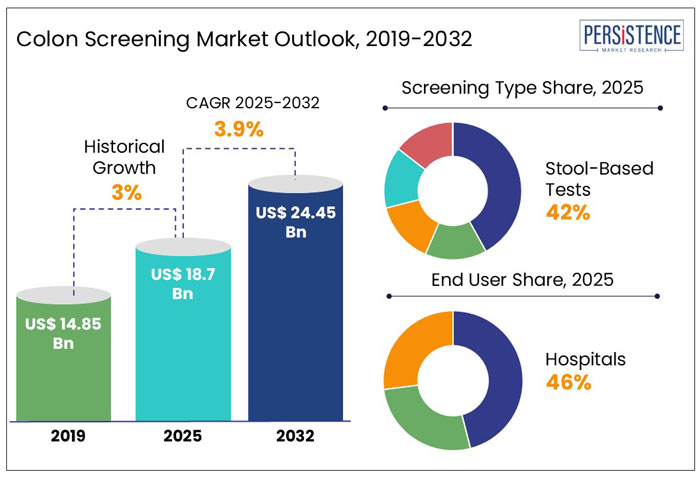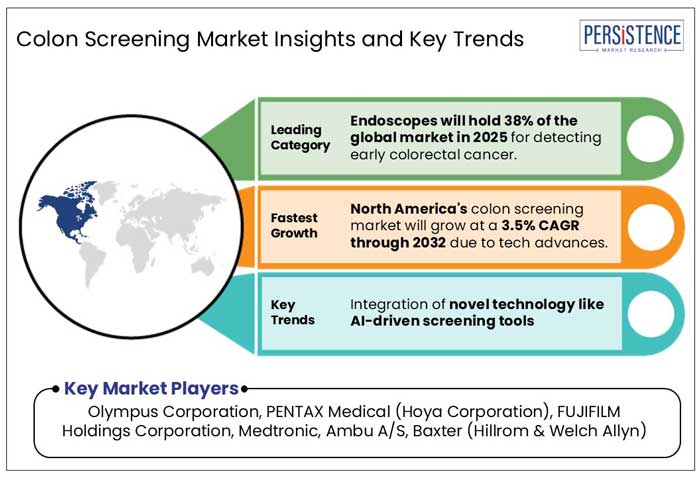Industry: Healthcare
Published Date: March-2025
Format: PPT*, PDF, EXCEL
Delivery Timelines: Contact Sales
Number of Pages: 181
Report ID: PMRREP35162
The global colon screening market size is anticipated to rise from US$ 18.7 Bn in 2025 to US$ 24.45 Bn by 2032. It is projected to witness a CAGR of 3.9% from 2025 to 2032. The rising incidence of colorectal cancer (CRC) worldwide is driving the expansion of screening programs and diagnostic testing.
According to the World Health Organization (WHO), 1.9 million new colorectal cancer cases were reported globally in 2020, making it the third most common cancer and the second leading cause of cancer-related deaths. With cases projected to surpass 3.2 million annually by 2040, governments and healthcare institutions are ramping up early detection efforts.
Countries like the U.S., U.K., and Japan have expanded their screening programs. They are doing more colonoscopies, fecal immunochemical tests (FIT), and DNA-based stool tests to help find cancer early and increase survival rates.

Key Highlights of the Colon Screening Market
|
Global Market Attributes |
Key Insights |
|
Market Size (2025E) |
US$ 18.7 Bn |
|
Market Value Forecast (2032F) |
US$ 24.45 Bn |
|
Projected Growth (CAGR 2025 to 2032) |
3.9% |
|
Historical Market Growth (CAGR 2019 to 2024) |
3.0% |
Spur in Research and Development in Colon Screening Presents Novel Prospects
As per Persistence Market Research, the global colon screening industry witnessed a CAGR of 3.0% in the historical period between 2019 and 2024. In the observed period, the demand for colorectal cancer screening has increased due to rising incidence rates and expanded screening programs.
According to the National Institutes of Health, the adoption of non-invasive screening methods like FIT and stool DNA tests has grown, with FIT participation reaching over 60% in some screening programs. In the U.S., the rates of CRC screening rose from 67% in 2019 to over 72% in 2023, driven by USPSTF recommendations lowering the screening age to 45.
The screening programs in Europe are expected to expand, with countries like Germany and the U.K. implementing broader population-wide initiatives. The shift toward home-based screening kits and AI-enhanced diagnostic tools has propelled market growth, increasing test volumes and early detection rates in the future.
Regulatory Support Worldwide Boosts the Integration of Novel Technology in Healthcare
In the estimated timeframe from 2025 to 2032, the global market for colon screening technology is likely to showcase a CAGR of 3.9%. The demand for advanced diagnostic tests and AI-driven colon screening tools is set to surge globally, driven by government and NGO-backed initiatives promoting early detection. AI-assisted screening methods, such as deep learning-based polyp detection systems, have improved colonoscopy accuracy and efficiency.
In 2023, over 500,000 AI-supported colonoscopies were performed across the globe, with adoption rising in countries like the U.S., China, and Germany.
Government programs, such as Cancer Moonshot in the U.S. and Europe’s Beating Cancer Plan, are driving investment in AI-powered screening technologies. AI-enhanced stool DNA tests are becoming increasingly popular for their above 90% sensitivity in detecting colorectal cancer, and they are predicted to be a key component of international cancer prevention initiatives.
Evolving Screening Programs Opens Up Novel Avenues for Research and Development
Since population-wide CRC screening programs encourage early identification, lower death rates, and save healthcare costs, they present substantial prospects for the screening and diagnostic industry.
According to the World Health Organization, CRC cases could surpass 3.2 million annually by 2040, emphasizing the need for mass screening initiatives. Countries like the U.S., U.K., and Japan have expanded national CRC screening, using methods such as colonoscopy, fecal immunochemical tests, and stool DNA tests.
In the U.S., the CDC’s Colorectal Cancer Control Program (CRCCP) aims to increase screening rates to 80%, thus reducing late-stage diagnoses. Studies show that regular screening can prevent 60% of CRC-related deaths, saving billions in treatment costs.
With countries like Germany and France putting in place FIT and colonoscopy programs, the European Union is broadening structured CRC screening. The need for cutting-edge diagnostic tests and AI-driven screening tools is anticipated to soar in subsequent years with the help of the government and non-governmental organizations.
Sensitivity Limitations of Screening Methods Hurdles the Early-Stage Neoplasms
Non-invasive colon screening methods like FIT and FOBT are widely used for early detection, but their sensitivity remains a concern, especially for early-stage neoplasms, despite their affordability and convenience.
Studies by the National Institutes of Health indicate that FIT has an overall sensitivity of 79% for detecting CRC, but its sensitivity drops to 24% to 50% for advanced adenomas, precancerous lesions that can develop into cancer.
In the same study, FOBT is anticipated to have a sensitivity of around 70%, which may lead to false negatives and delayed diagnoses. Due to these limitations, high-risk individuals still require colonoscopy follow-ups for definitive detection.
Despite their limitations, population-wide screening programs, such as the U.K.'s NHS Bowel Cancer Screening Program and the U.S. CDC's Colorectal Cancer Control Program, promote FIT and FOBT to improve early detection and reduce mortality. Such programs are projected to control the sensitivity issues in the screening methods in the forthcoming years.
Development of Telemedicine and Home Testing Tools Presents Prospects for Fast Results
The rise of telemedicine and home testing is reshaping colon cancer screening methods, making them more accessible, especially in underserved areas. Portable, non-invasive tools like FIT and stool DNA tests have increased participation in screening programs.
In the U.S., at-home CRC screening participation grew by 10% from 2019 to 2023, with FIT and Cologuard® stool DNA tests leading the way. The Colorectal Cancer Alliance reports that nearly 40% of eligible adults still do not get screened, indicating substantial market opportunities.
Companies such as Exact Sciences and Guardant Health are improving the accuracy of at-home blood tests by employing AI-based risk assessments and telemedicine platforms to guide patients toward appropriate screening options.
Furthermore, governments and NGOs are promoting the availability of free FIT kits and enhancing rural screening rates through initiatives like those from the NHS and CDC. These efforts aim to reduce disparities in healthcare and drive market growth in the upcoming timeframe.
Innovations in CBD Ingestibles Shape the Future of Wellness
Based on screening type, the global colon screening market is categorized into stool-based tests, colonoscopy, flexible sigmoidoscopy, capsule endoscopy, and others. Stool-based tests are projected to account for 42% of the market in 2025, owing to their non-invasive nature, affordability, and increasing adoption in at-home screening programs.
These tests include fecal immunochemical tests (FIT) and guaiac-based fecal occult blood tests (gFOBT), which are widely recommended in national screening initiatives. The U.S. Preventive Services Task Force (USPSTF) and European healthcare agencies endorse these methods, increasing compliance rates.
Following that, colonoscopy is anticipated to hold 35% of the market and remains the gold standard for colorectal cancer detection due to its high sensitivity, which is over 95%, and ability to detect and remove polyps in a single procedure. Despite its invasiveness, countries like Germany, the U.S., and Japan promote population-wide colonoscopy programs for high-risk individuals.
Capsule endoscopy and flexible sigmoidoscopy are gaining traction but remain secondary choices. The integration of AI in colonoscopy procedures is enhancing diagnostic accuracy, ensuring continued market growth in the projected years.
Endoscopes Lead the Way in Minimally Invasive Cancer Screening
On the basis of product types, endoscopes are expected to hold a market share of 38% on the global scale in 2025. This is because they detect precancerous polyps and early-stage colorectal cancer with an accuracy of over 95%. Colonoscopies, which use advanced high-definition and AI-assisted endoscopes, are considered the best method. This is especially true in Germany, the U.S., and Japan, where national screening programs focus on them.
Test kits and reagents follow closely, accounting for 27% of the market, as non-invasive stool-based tests like FIT and FOBT continue to gain popularity. Their affordability, at-home convenience, and growing government adoption in Europe and North America support their widespread use.
CT scanners are estimated to account for 20% of the market, with virtual colonoscopy (CT colonography) gaining popularity because of its lower invasiveness. The demand for CT scanners is increased by integrating CT colonography into screening programs in countries like the U.K. and Canada.

Innovations in Colon Screening Technology Offer Great Outcomes in North America
In 2025, North America is expected to attain a market share of 44% of the global colon screening market. Healthcare technology innovations in North America are improving early detection rates and patient outcomes through AI-powered colonoscopy tools like Medtronic's GI Genius™. Owing to such advances in healthcare technology, North America is estimated to report a CAGR of 3.5% through 2032.
In 2023, over 50,000 cases of CRC were diagnosed in the U.S., making improved screening essential. Exact Sciences’ Cologuard® 2.0, an advanced stool DNA test with 94% sensitivity, was approved by the FDA in 2023, further driving non-invasive screening adoption.
The American Cancer Society reports that CRC screening participation increased by 7% from 2019 to 2024, partly due to expanding telemedicine and at-home test availability. With government-backed initiatives like the CDC’s Colorectal Cancer Control Program, the region is witnessing strong growth in diagnostic advancements, improving patient survival rates.
Rise in Screening Programs in Europe Implements Broader Population-Wide Initiatives
Europe is projected to hold 24% of the global colon screening market by 2025, largely due to Germany, France, and the U.K.'s widespread adoption of screening programs and nationwide initiatives aiming to increase early detection rates.
In Germany, the National Cancer Plan supports biennial FIT/FOBT tests for individuals aged 50 to 54, followed by colonoscopy every 10 years for those 55 and older.
The U.K.’s Bowel Cancer Screening Programme lowered the screening age to 50, increasing participation rates. In 2024, over 60% of the eligible population in the U.K. and Germany participates in CRC screening.
The European Commission’s Beating Cancer Plan aims to screen 90% of the EU population eligible for CRC screening by 2040. Expanding these programs could prevent up to 35,000 deaths annually, reinforcing the importance of government and NGO-supported screening efforts. Advancements in non-invasive tests like FIT-DNA and AI-assisted colonoscopies are also boosting adoption rates across Europe.
Rising Geriatric Patient Pool of Asia Pacific Presents Avenues in Precision Medicine
Asia Pacific is projected to be the fastest-growing market for colorectal cancer diagnostics, driven by an aging population in the region and increasing awareness of early detection. China alone recorded 555,477 new CRC cases in 2020, making it the second most common cancer in the country. Japan reported 149,500 new cases, while India saw over 65,000. The rising burden of genetic disorders like Lynch syndrome and familial adenomatous polyposis contributes to 5% to 10% of all CRC cases in the region.
Governments in South Korea and Singapore are implementing population-wide screening programs to boost early detection. South Korea’s National Cancer Screening Program (NCSP) offers biennial FIT tests for individuals over 50, increasing participation rates.
Asia Pacific's development in colorectal cancer diagnostics is supported by the development of non-invasive stool-based tests and investment in precision medicine, which are improving diagnosis accuracy and customizing screening methods.
In the global healthcare sector, colon screening has become increasingly vital due to the alarming rise in colon cancer cases worldwide. The trend has prompted several technology companies to explore collaborations with healthcare institutions, aiming to enhance their consumer reach and improve patient outcomes.
The integration of cutting-edge technologies into colon screening platforms is expected to significantly enhance the accuracy and efficiency of these tests, leading to more precise early detection of potential issues.
As awareness about cancer treatment and prevention grows, so too will the understanding and knowledge surrounding the importance of regular screenings, empowering individuals across the globe to take proactive steps in safeguarding their health.
Key Industry Developments
|
Report Attributes |
Details |
|
Historical Data/Actuals |
2019 - 2024 |
|
Forecast Period |
2025 - 2032 |
|
Market Analysis Units |
Value: US$ Bn/Mn, Volume: As applicable |
|
Geographical Coverage |
|
|
Segmental Coverage |
|
|
Competitive Analysis |
|
|
Report Highlights |
|
|
Customization and Pricing |
Available upon request |
By Screening Type
By Product Type
By End User
By Region
To know more about delivery timeline for this report Contact Sales

The market is set to reach US$ 25.15 Bn in 2025.
In 2025, colonoscopy and stool-based tests are expected to be crucial for detecting and removing polyps and certain cancers in the rectum and entire colon.
Olympus Corporation, PENTAX Medical (Hoya Corporation), FUJIFILM Holdings Corporation, Medtronic, and Ambu A/S are a few leading players.
The industry is estimated to rise at a CAGR of 3.9% through 2032.
North America is projected to hold the largest share of the industry in 2025.